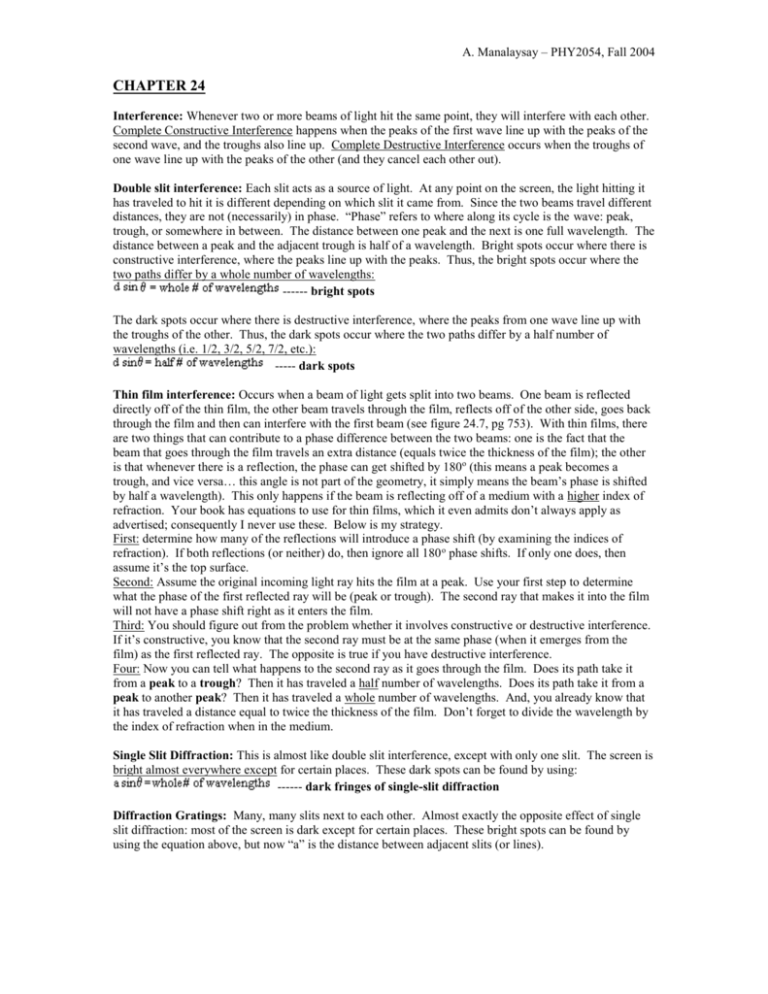ch24_review
advertisement

A. Manalaysay – PHY2054, Fall 2004 CHAPTER 24 Interference: Whenever two or more beams of light hit the same point, they will interfere with each other. Complete Constructive Interference happens when the peaks of the first wave line up with the peaks of the second wave, and the troughs also line up. Complete Destructive Interference occurs when the troughs of one wave line up with the peaks of the other (and they cancel each other out). Double slit interference: Each slit acts as a source of light. At any point on the screen, the light hitting it has traveled to hit it is different depending on which slit it came from. Since the two beams travel different distances, they are not (necessarily) in phase. “Phase” refers to where along its cycle is the wave: peak, trough, or somewhere in between. The distance between one peak and the next is one full wavelength. The distance between a peak and the adjacent trough is half of a wavelength. Bright spots occur where there is constructive interference, where the peaks line up with the peaks. Thus, the bright spots occur where the two paths differ by a whole number of wavelengths: ------ bright spots The dark spots occur where there is destructive interference, where the peaks from one wave line up with the troughs of the other. Thus, the dark spots occur where the two paths differ by a half number of wavelengths (i.e. 1/2, 3/2, 5/2, 7/2, etc.): ----- dark spots Thin film interference: Occurs when a beam of light gets split into two beams. One beam is reflected directly off of the thin film, the other beam travels through the film, reflects off of the other side, goes back through the film and then can interfere with the first beam (see figure 24.7, pg 753). With thin films, there are two things that can contribute to a phase difference between the two beams: one is the fact that the beam that goes through the film travels an extra distance (equals twice the thickness of the film); the other is that whenever there is a reflection, the phase can get shifted by 180o (this means a peak becomes a trough, and vice versa… this angle is not part of the geometry, it simply means the beam’s phase is shifted by half a wavelength). This only happens if the beam is reflecting off of a medium with a higher index of refraction. Your book has equations to use for thin films, which it even admits don’t always apply as advertised; consequently I never use these. Below is my strategy. First: determine how many of the reflections will introduce a phase shift (by examining the indices of refraction). If both reflections (or neither) do, then ignore all 180 o phase shifts. If only one does, then assume it’s the top surface. Second: Assume the original incoming light ray hits the film at a peak. Use your first step to determine what the phase of the first reflected ray will be (peak or trough). The second ray that makes it into the film will not have a phase shift right as it enters the film. Third: You should figure out from the problem whether it involves constructive or destructive interference. If it’s constructive, you know that the second ray must be at the same phase (when it emerges from the film) as the first reflected ray. The opposite is true if you have destructive interference. Four: Now you can tell what happens to the second ray as it goes through the film. Does its path take it from a peak to a trough? Then it has traveled a half number of wavelengths. Does its path take it from a peak to another peak? Then it has traveled a whole number of wavelengths. And, you already know that it has traveled a distance equal to twice the thickness of the film. Don’t forget to divide the wavelength by the index of refraction when in the medium. Single Slit Diffraction: This is almost like double slit interference, except with only one slit. The screen is bright almost everywhere except for certain places. These dark spots can be found by using: ------ dark fringes of single-slit diffraction Diffraction Gratings: Many, many slits next to each other. Almost exactly the opposite effect of single slit diffraction: most of the screen is dark except for certain places. These bright spots can be found by using the equation above, but now “a” is the distance between adjacent slits (or lines). Polarization: Recall, a beam of light is made up of electric and magnetic fields. Also, you know that a magnetic field is a vector, which means that along with magnitude, it has a direction. For a beam of light, the direction of its electric field is perpendicular to the direction that the wave travels (kind of like wave on a string). The direction that the electric field is pointing in a beam of light is the polarization direction of the light. A Polarizing filter is a filter which only lets light through that has a specific polarization. This particular direction is called the axis of the filter. If I shine some light on a polarizing filter, it will change the intensity of the light: I = I0 cos2 ----- only valid if the initial light is polarized In this case, “I” is the intensity after the light has passed through the filter, “I0” is the initial intensity, and is the angle between the initial polarization direction of the light and the axis of the filter. Typically, most light you see is made up of beams of all different polarizations, so we call this un-polarized light. If un-polarized light goes through a polarizing filter, it cuts the intensity in half: I = I0 / 2 ------- for light that is initially un-polarized.





